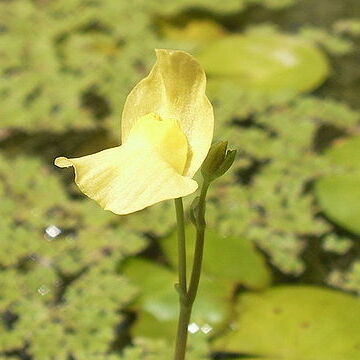Aquatic. Rhizoids usually present, verticillate at or near the base of the peduncle, fusiform, inflated, 2-6 cm long, 1-3 mm thick (Fig. 23), with filiform branches bearing botryform clusters of ellipsoid segments 0.1-0.2 mm long. Stolons filiform to relatively thick, up to 50 cm long, terete, branched, glabrous or ± densely covered with short simple hairs. Foliar organs numerous and conspicuous 2-6 cm long, primary segments 3-4, semi-verticil-late, filiform or sometimes thick and inflated, each pinnately repeatedly divided from near the base into numerous segments, ultimate segments capillary, terete, setulose; stipule-like clusters of short capillary setulose segments usually present at the base of the primary segments. Traps usually numerous, lateral on the foliar segments and sometimes also in the angle between segments, obliquely ovoid, shortly stalked, 1-4 mm long, mouth lateral, upper lip usually with 2 short sparsely branched setiform appendages or without appendages. Inflorescence erect, 5-25 cm long; peduncle filiform, terete, glabrous; flowers 5-10, initially congested becoming ± distant; scales always absent; bracts basifixed, ± orbicular, 1.5-2 mm long, apex rounded or subacute; bracteoles absent; pedicels filiform, dorsiventrally flattened, elliptic in cross section, 4-20 mm long, erect at anthesis, usually sharply reflexed and thickened, especially apically, in fruit. Calyx lobes subequal, the upper slightly longer, ovate, 3-4 mm long at anthesis, rather fleshy, apex obtuse, margins strongly incurved, very accrescent, up to 9 mm long and spreading or reflexed in fruit. Corolla yellow, externally glabrous or sparsely hairy, 10-15 mm long, upper lip broadly ovate, about twice as long as the upper calyx lobe, apex rounded, lower lip larger, transversely elliptic, apex rounded, entire or retuse palate raised, gibbous, spur cylindrical from a conical base, often constricted at the middle, apex obtuse, slightly shorter than and ± parallel with the lower lip. Filaments linear, expanded above, c. 2 mm long, anther thecae confluent. Ovary globose, glandular, style relatively long, stigma lower lip orbicular, margin hyaline, ciliate, upper lip much shorter, margin glabrous. Capsule globose up to 5 mm long, relatively thick and fleshy, circumscissile, style usually greatly enlarged and elongated, often equalling or exceeding the capsule. Seeds numerous, lenticular-prismatic, 5-angled, 1.5-2 mm wide, very narrowly winged on all the angles, testa thin, obscurely reticulate, reticulations slightly elongate.
More
Perennials or annuals, suspended aquatic. Rhizoids usually present, verticillate at base or shortly above base of peduncle, fusiform, inflated, with filiform branches. Stolons filiform to relatively thick, branched. Traps on leaf segments, stalked, obliquely ovoid, 1-4 mm, mouth lateral or basal; appendages 2 or sometimes absent, dorsal, sparsely branched, setiform. Leaves numerous on stolons, 2-8 cm, divided from base into 3 or 4(or 5) semiverticillate primary segments; primary segments ovate to oblong-lanceolate in outline, 1.5-3 cm wide, pinnately divided into secondary segments; secondary segments dichotomously divided from base into numerous further segments; ultimate segments capillary, slightly flattened, laterally and apically setulose; stipulelike auricles usually present at base of primary segments, semicircular in outline, divided dichotomously into filiform sparsely setulose segments. Inflorescences erect, 5-25 cm, 3-10-flowered, glabrous; peduncle terete, 0.5-1.5 mm thick; scales absent; bracts basifixed, broadly ovate to orbicular, 1-2 mm, apex rounded. Pedicel erect at anthesis but sharply deflexed and thickened in fruit, 0.4-2 cm, dorsiventrally compressed; bracteoles absent. Calyx lobes ovate, subequal, apex rounded to subacute; lower lobe often slightly broader than upper lobe, 2-3 mm at anthesis, becoming fleshy, 7-9 mm, and spreading to reflexed in fruit. Corolla pale yellow, 1-1.5 cm, pubescent or glabrous; lower lip transversely elliptic, base with a prominent 2-lobed swelling, apex rounded to emarginate; spur cylindric from a narrowly conic base, ± as long as and parallel with lower lip, straight or slightly curved, apex obtuse to subacute; palate pubescent; upper lip broadly ovate, apex rounded. Filaments 1-1.5 mm, curved; anther thecae ± confluent. Ovary ovoid; style evident; stigma lower lip semicircular, upper lip obsolete. Capsule globose, 4-5 mm in diam., circumscissile; persistent style greatly enlarged and elongated, often equaling or exceeding capsule. Seeds prismatic, 1-2 mm wide, 5-or 6-angled, narrowly winged on all angles; seed coat with ± isodiametric obscure reticulations. Fl. Jun-Nov, fr. Jul-Dec. 2n = 80.


